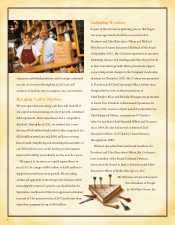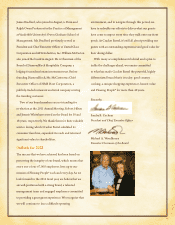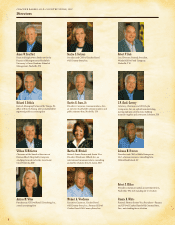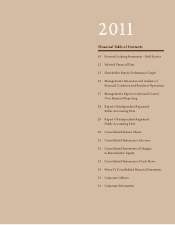Cracker Barrel 2011 Annual Report Download - page 18
Download and view the complete annual report
Please find page 18 of the 2011 Cracker Barrel annual report below. You can navigate through the pages in the report by either clicking on the pages listed below, or by using the keyword search tool below to find specific information within the annual report.
We believe that the comparable store retail sales increase
from 2010 to 2011 resulted from a more appealing
retail merchandise selection and a higher average retail selling
price than in the prior year partially offset by a decrease
in restaurant guest traffic. Our comparable store retail sales
decrease from 2009 to 2010 resulted from a decrease in
restaurant guest traffic.
We believe that the decreases in restaurant guest traffic in
2010 and 2011 resulted from continued uncertain consumer
sentiment, high unemployment and reduced discretionary
spending. Our guest traffic began to decline in the second
quarter of 2011 and continued to decrease in the second half
of 2011. We presently expect lower guest traffic trends to
continue into 2012.
Cost of Goods Sold
e following table highlights the components of cost of
goods sold in dollar amounts for the past three years:
2011 2010 2009
Cost of Goods Sold:
Restaurant $511,728 $489,781 $501,051
Retail260,743 256,037 263,858
Total Cost of Goods Sold $772,471 $745,818 $764,909
Restaurant cost of goods sold as a percentage of restaurant
revenue was 26.5%, 25.6% and 26.7% in 2011, 2010 and
2009, respectively. e increase from 2010 to 2011 is primarily
the result of food commodity inflation of 2.9% partially
offset by our menu price increase referenced above. Changes
in product mix and higher food waste also contributed to
the year over year increase in restaurant cost of goods sold as
a percentage of restaurant revenue. e decrease from 2009
to 2010 resulted from commodity deflation of 2.5% and our
menu price increase referenced above.
Restaurant food commodity inflation progressively
increased during 2011 and we presently expect the rate of
commodity inflation to approximately double in 2012
as compared to 2011. We expect to offset the effects of food
commodity inflation through a combination of menu price
increases, supply contracts and other cost reduction initiatives.
Retail cost of goods sold as a percentage of retail revenue
was 52.1%, 52.0% and 53.7%, in 2011, 2010 and 2009,
respectively. Retail cost of goods sold as a percentage
of retail revenue was relatively constant in 2011 as compared
to 2010. e decrease from 2009 to 2010 resulted from lower
markdowns as a result of beer seasonal inventory management.
Labor and Related Expenses
Labor and other related expenses include all direct and
indirect labor and related costs incurred in store operations.
Labor and other related expenses as a percentage of total
revenue were 37.1%, 37.8% and 38.7% in 2011, 2010 and 2009,
respectively. e year-to-year decrease from 2010 to 2011
resulted primarily from decreases of 0.3%, 0.2% and 0.2% as a
percentage of total revenue, respectively, in store management
compensation, health care costs and store hourly labor. e
decrease in store management compensation resulted primarily
from lower store bonus expense, which reflected lower
performance against financial objectives as compared to the
prior year. e decrease in health care costs resulted from
lower medical claims. e decrease in store hourly labor costs
as a percentage of total revenue resulted from menu price
increases being higher than wage inflation.
e year-to-year decrease from 2009 to 2010 resulted from
decreases of 0.7% and 0.2% as a percentage of total revenue,
respectively,in health care costs and storehourly labor costs.
e decrease in health care costs resulted from lower medical
claims and the benefit of the calendar 2010 group health
plan design changes. e decrease in store hourly labor costs
as a percentage of total revenue resulted from menu pricing
being higher than wage inflation.
Other Store Operating Expenses
Other store operating expenses include all store-level
operating costs, the major components of which are utilities,
operating supplies, repairs and maintenance, depreciation and
amortization, advertising, rent, credit card fees and general
insurance. Other store operating expenses as a percentage of
total revenue were 18.6%, 18.2% and 17.8% in 2011, 2010
and 2009, respectively. e year-to-year increase from 2010 to
2011 resulted primarily from equal increases in advertising,
supplies and general insurance expenses. e increase in
advertising expense resulted from increased spending related
to billboards and consumer research as compared to the prior
year. We purchased additional billboard coverage during
the 2011 summer travel season to beer capture available guest
traffic. Additionally, the incremental consumer research
16
B)LQDQFLDOLQGG 30
























